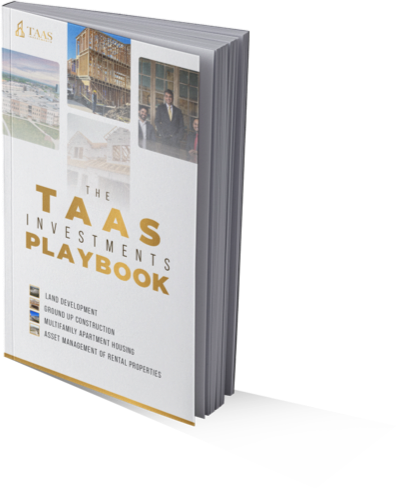Multifamily real estate investing, encompassing the acquisition and management of properties with multiple separate living units such as apartments, duplexes, and townhomes, is a strategic avenue for investors aiming for stable income, capital appreciation, and portfolio diversification. This guide expands on the classifications of multifamily properties, explores various investment strategies, and highlights the significant tax advantages that may make multifamily investing a great vehicle to accumulate generational wealth.
Understanding Multifamily Properties
Multifamily properties are generally classified into Class A, B, C, and D, each distinguished by different levels of risk, reward, and investment strategy. These classifications consider the property’s age, demographics of the tenant base, location, and condition:
- Class A: These are the newest and most luxurious properties, often located in prime urban or suburban areas. They feature state-of-the-art amenities and are designed to attract high-income tenants. The appeal of Class A properties lies in their modernity, security, and the lifestyle they offer, commanding the highest rents in the market.
- Class B: Often referred to as “workforce housing,” Class B properties are typically 15 to 40 years old and may require minor updates. They offer a balance between affordability and quality, appealing to middle-income tenants. These properties present an opportunity for moderate value-add strategies to enhance their appeal and increase rental income.
- Class C: These are the oldest properties are also referred to as “workforce housing”, usually more than 40 years old, located in less desirable neighborhoods, and catering to lower-income tenants. Class C properties may have functional issues and outdated systems but may offer significant opportunities for renovation and repositioning in the market.
- Class D: Properties in poor condition located in lower demographics. Investing in Class D properties involves a high level of risk but can offer substantial returns if the property can be successfully renovated and stabilized.
Investment Strategies in Multifamily Real Estate:
Investing in multifamily real estate encompasses a variety of strategies, each tailored to different property classes and investor goals. From enhancing undervalued properties to constructing new developments, these strategies offer diverse pathways to profitability. Here’s a closer examination of each:
Value-Add: The value-add strategy is about identifying multifamily properties that, with the right improvements, can significantly increase in value. While Class A properties can also be a candidate, this approach often targets Class B, C and D properties that may be underperforming due to outdated designs, inefficient operations, or poor management. The key to success in value-add investments lies in the ability to execute a well-planned renovation and rebranding campaign that enhances the property’s appeal to tenants and, consequently, its rental income. This might include modernizing units, adding amenities, or improving energy efficiency. While this strategy requires upfront capital investment, the potential for a substantial increase in property value and rental income can offer attractive returns. It’s suited for investors who are willing to take on a project with a clear vision for transformation.
Yield Play: Yield play is a strategy focused on acquiring multifamily properties that are already stable and generating consistent cash flow. These properties, typically Class A and B, require minimal improvements and offer investors a lower-risk entry point into real estate investment. The appeal of the yield play strategy lies in its predictability and lower operational demands, making it an excellent option for investors seeking steady, long-term returns without the complexities of extensive renovations or new construction. This approach can be particularly attractive in established markets with strong rental demand, where occupancy rates and rental incomes are stable. Investors who prioritize cash flow and risk mitigation over rapid growth may find the yield play strategy to be a perfect fit.
Development: The development strategy involves the ground-up construction of new multifamily units, a process that can significantly revitalize neighborhoods or meet unaddressed housing demands in growing areas. This approach targets the creation of Class A properties, offering modern amenities and designs that attract premium rents. Success in development hinges on a thorough understanding of market demands, zoning laws, construction costs, and project management. While the financial and operational risks could be higher, the potential for substantial capital appreciation and the opportunity to shape a property from the ground up can offer unparalleled rewards. This strategy is best suited for experienced developers with the resources and expertise to navigate the complexities of real estate development.
Distressed Investments: Investing in distressed properties targets multifamily assets that are underperforming, often with occupancy rates below 70%, due to financial difficulties, management issues, or poor condition. This strategy aims to acquire these properties at a significant discount, address their challenges through strategic renovations, operational improvements, or restructuring, and then either sell them for a profit or hold them for enhanced cash flow. Distressed investment requires a keen eye for potential, a high tolerance for risk, and a comprehensive plan for turning the property around. While the risks are substantial, so are the potential rewards for investors who can successfully rehabilitate and reposition a distressed asset in the market.
Advantages of Multifamily Investments:
Multifamily real estate investing offers a unique blend of benefits that can cater to both seasoned and novice investors. These advantages not only underscore the potential for high returns and portfolio growth but also highlight the strategic resilience of multifamily properties in varying economic climates. Here’s a more detailed exploration of each advantage:
1. Higher Returns and Scalability: The appeal of multifamily investments primarily lies in their potential for higher returns and scalability. Owning a property with multiple units allows investors to significantly boost their rental income in comparison to single-family properties. This increase is due to each unit contributing to the total cash flow, thereby enhancing profit potential. Unlike single-family properties, whose value is often swayed by market sentiment, the value of multifamily properties is more closely tied to their Net Operating Income. Furthermore, multifamily properties offer scalability within an investor’s portfolio. Rather than acquiring and managing a multitude of single-family homes, investors can consolidate their efforts into larger multifamily assets. This strategy not only streamlines property management but can also facilitate more efficient growth of their real estate portfolio.
2. Tax Benefits: One of the most compelling reasons to invest in multifamily real estate is the array of tax benefits it offers. These benefits include deductions for mortgage interest, repairs, rehabs, and operational expenses, which can significantly reduce taxable income. Additionally, Bonus Depreciation is a powerful tool that allows investors to accelerate depreciation on certain aspects of the property, offering substantial tax savings in the early years of ownership. This accelerated depreciation can offset income, thereby lowering tax obligations and improving cash flow. It’s a strategic advantage that enhances the overall attractiveness of multifamily investments.
3. Predictable Cash Flow: The constant demand for housing secures a steady rental income from multifamily properties, offering investors a dependable cash flow. This predictability is a significant advantage, ensuring a reliable revenue stream. The diversification across multiple units reduces the risk of complete income loss, as it’s unlikely all units will be vacant simultaneously. Moreover, in robust rental markets, vacancies can be quickly filled, sustaining high occupancy rates and uninterrupted income. The current market trends show that total income from multifamily properties can be increased by providing in-house WiFi, video, and smart home features. This blend of rental income and additional services not only boosts the total revenue but also stabilizes it, making it an attractive option for investors looking to build a strong, resilient investment portfolio.
4. Recession Resistance and Inflation Hedge: Multifamily properties are inherently resilient to economic downturns due to the perpetual need for affordable housing. During recessions, when homeownership may become less accessible, the demand for rental units often increases, supporting stable or even rising rental rates. Additionally, the relatively short lease terms associated with multifamily units allow for rent adjustments in response to inflation. This flexibility enables investors to protect their income against inflationary pressures, ensuring that rental income keeps pace with rising costs. As a result, multifamily investments can offer a hedge against both recession and inflation, underscoring their strategic value in a diversified investment portfolio.
Conclusion
Multifamily real estate investing presents a compelling blend of stability, income potential, and resilience to economic fluctuations, augmented by significant tax advantages. Understanding the nuances of property classifications, strategic investment approaches and tax benefits including Bonus Depreciation, is crucial for navigating the multifamily sector successfully. With its proven track record of weathering recessions and thriving during inflationary periods, multifamily investments offer a robust case for those looking to build wealth over the long term.
This article is provided by TAAS Investments for informational purposes only and does not constitute legal, tax, or investment advice. Prospective investors should consult with professional advisors to assess the suitability of any investment. TAAS Investments makes no representations or warranties as to the accuracy or completeness of the information contained herein.









